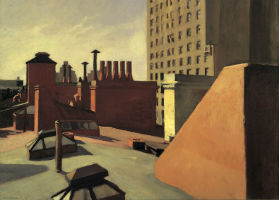
NEW YORK – An anonymous donor has promised two major prewar American paintings to the Whitney Museum of American Art Museum’s permanent collection: Edward Hopper’s 1932 painting City Roofs and Childe Hassam’s Allied Flags, April 1917, also known as Allied Flags, Union League Club (1917).
“We are thrilled that these two wonderful paintings, City Roofs and Allied Flags, April 1917, have been promised to the Whitney,” said Director Adam D. Weinberg, who announced the gift Friday. “Thanks to the generosity of an anonymous donor, these paintings, long held in private hands, will be available in coming years to new generations who visit the Whitney to see works from our iconic collection and discover the history of American art. These are among the Whitney’s most important acquisitions of recent years, and they add tremendously to our holdings of early 20th-century American art.”
City Roofs depicts the rooftop of Edward Hopper’s studio at 3 Washington Square North in Greenwich Village. Hopper (1882–1967) was frequently inspired by the two locations in which he spent most of his time: downtown New York, where he lived and worked in the same rented apartment from 1913 until his death in 1967, and Cape Cod, where, beginning in 1934, he maintained a home and studio.
Although Hopper made many works that revisit favorite sites and motifs, he completed only one painting of the roof of his New York home. A reflective and solitary man, Hopper was deeply attuned to the complex rhythms of everyday life.
“The subject of an urban rooftop offers a metaphor for Hopper’s artistic career,” David Breslin, curator and director of the collection. “The utterly ordinary yet frequently inaccessible location holds the same promise of uniqueness and hidden depth as the solitary figures populating so many of his compositions.”
City Roofs joins the Whitney’s unparalleled collection of Hopper’s work, which includes over 200 paintings, more than 2,500 drawings, as well as numerous prints and watercolors, many of which were bequeathed to the museum by his widow, Josephine Nivison Hopper.

Childe Hassam (1859–1935) was a pioneer of American Impressionism. The most well-known practitioner of this French-invented painting style, he was also one of the only American Impressionists to depict the home front during World War I. From 1916 until 1919, Hassam produced a series of flag paintings, approximately 30 works representing Fifth Avenue and adjacent streets decorated with patriotic banners. This is the first painting by Hassam to enter the Whitney’s collection.
“Hassam completed this work during the month the United States officially entered the war,” noted Breslin, “and it is a particularly significant painting from the series because he depicts himself among the pedestrians. By including himself in this way, the artist seems to suggest that he, like all Americans at that moment, was personally involved in the war effort.”



